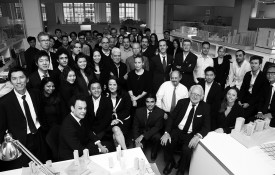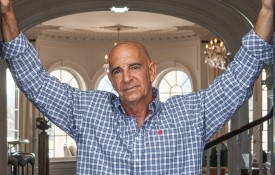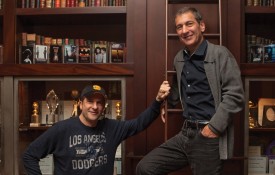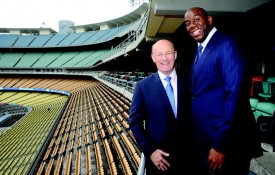Shortly after Patrick Soon-Shiong purchased the Los Angeles Times from Tronc (now Tribune Publishing) in 2018, he called on Norman Pearlstine to orchestrate a path for the prestigious institution’s revitalization. Amid the shifting terrain of new media, Pearlstine was a seasoned editor who knew the business of publishing from the inside out and whose journalistic integrity would not be influenced by ownership.
Pearlstine had risen through the ranks of the newsroom of The Wall Street Journal in the late 1960s, going on to hold a succession of prestigious posts at Forbes, Bloomberg News, and Time Inc. in the ensuing decades. He understood the business and practice of journalism and the necessity for it to adapt to the changing times. Coaxed out of retirement to assume the top editorial post at the largest American newspaper not headquartered on the East Coast, Pearlstine set out to turn the paper’s fortunes around. He had the backing of a new owner with deep pockets who believed print journalism would become relevant to a new generation.
On paper, the outlook was rosy. However, the task would become complicated by the onset of a global pandemic, as well as a couple of well-publicized incidents in the L.A. Times newsroom that reflected racial divisions flaring up in cities across the country. While he always considered his role an “interim” assignment, Pearlstine announced in October that he would be stepping down as executive editor, effectively fast-tracking the search for his successor. CSQ had the opportunity to speak to Pearlstine several weeks before he made the announcement, and he shared his candid thoughts about journalism, its fiscal feasibility, and its morphing role in society.
What would you say shaped your goals and served as your motivation for your professional journey?
I grew up in a small farm town west of Philadelphia. My father was a senior partner in a 20-person law firm that included six of his relatives. Most of the pressure was to go to law school, but beginning with my high school newspaper and then in college, I got really interested in journalism.
Before my sophomore year, I wrote to 30 newspapers asking for a summer internship; 29 turned me down. … The Allentown Chronicle offered me a job on the spot for $55 a week, so I worked as a summer intern. After college, I went to law school, because of that family pressure, and I did not get back into journalism until I took and passed the bar exam. I then ended up becoming a copy boy at The New York Times. I was a terrible copy boy. I was about to be fired when The Wall Street Journal offered me a reporting job in Dallas. I was lucky to have left The New York Times when I did, and The Wall Street Journal was a wonderful place to spend 23 years.

Norman Pearlstine (Photo credit: Jay L. Clendenin, L.A. Times).
How did you make the distinct transition from reporter to management?
In 1975, The Wall Street Journal decided to start The Asian Wall Street Journal. There were two correspondents in Asia at the time—Peter Kann in Hong Kong, and I was stationed in Tokyo. So they tapped us to start it. He was the editor and publisher and I was the managing editor. Neither of us knew about management, but the initial belief was that we’d be chopping down stories from the U.S. edition. We were into it for about a week when we realized the only future was going to be covering Asia financial news, and so we started putting together a staff. That’s how I got into management.
Early on I came to understand that, in many cases, the more you delegate, the more you get to do. When I look back on my career … I would say I’m best known for the extraordinary journalists to whom over the years I was able to delegate authority and responsibility. People like Walter Isaacson at Time, Martha Nelson at InStyle and People, and Paul Steiger at The Wall Street Journal would be examples.
What was your motivation for accepting the offer to become executive editor at the L.A. Times?
I’ve worked in L.A. twice before and have always loved the West Coast. I spent my first years at The Wall Street Journal near L.A., and I spent two years with Forbes in L.A. Even during my years at Time Inc., I spent a lot of time in California. Due to Time Inc. properties like InStyle, Entertainment Weekly, People, and Essence, there was good reason to be here.
When Patrick, who had originally asked me to help him find an editor, turned around and asked me if I would do it, it was like a dream come true. I realized, however, the L.A. Times had been through a very turbulent time. When I came in, I was the 11th editor in 21 years. … Here was a lot of instability, but at the same time a very talented staff that held the place together heroically.
Finally, I believe that Los Angeles, California, and the West have a different point of view, a grounding, and there was an opportunity with the L.A. Times to not only do the kind of great journalism that you’d expect a publication with a national and global audience would have, but there was also something special about the city, county, state, and region that made it an exciting possibility.
The commitment to Patrick Soon-Shiong, at his request, was that we put together a leadership team for the future. I saw the job as attractive because of the location, because of the story, and because of the opportunity to take a grand, storied publication from the print-centric place it had been into being a multi-platform publication that really is responsive to the needs of not only a geographic audience in Southern California but also a psychographic audience: people who care about what Southern Californians do and think about.
What was the biggest challenge you faced when you accepted the role?
I saw the looming editorial issues but … Tronc had consolidated … many of the business functions in Chicago subsequently affecting timeliness of business and IT support.
Add to that an economy that was so damaged by the pandemic. Ad-supported media has been under extraordinary pressure since March 2020. We’ve been pushing a more dynamic relationship with our audience. Those were the trends, but in the past six months, the trends accelerated in what I would have thought would have taken six years.
The question of whether we will be printing seven days a week or something less frequent was not on anybody’s mind a couple years ago. But the combination of technology in terms of how people are using mobile, coupled with changing the dynamics of how we distribute our publications or how we reach new audiences, requires an investment in technology.
For hundreds of years, since Gutenberg, we had a “one to many” model, where editors told people what to read. Now we have a two-way relationship with our customers. It’s very much “What do we have?” and “What do people want?” And increasingly, the growth areas are going to be in video, mobile, and events, and there are extraordinary challenges that come along with that, that really do require a great use of technology. Ideally, we should try to figure out what machine learning can do so we can free up our journalists to do things that technology cannot address.
How have the national conversations about race and reckonings within media companies been playing out at the L.A. Times?
The ways in which a protest movement growing out of George Floyd’s death has migrated into the newsroom—raising serious questions about management’s commitment to inclusiveness, about management’s understanding of the difference between being racist, not being racist, and being anti-racist, and how that might impact your coverage—I think has actually been healthy for us, although painful.
What do you see as the primary role or characteristic that distinguishes the L.A. Times’ place in journalism in the 21st century?
If The New York Times is known for “All the news that’s fit to print” and The Washington Post is “Democracy dies in darkness,” if the L.A. Times were to have a slogan, it would be “Your window on the future.” The idea that society at large ought to be thinking the way that Californians are thinking … but also it would capture the innovation and inspiration that continues to draw people to Los Angeles even as others are deciding to leave.
You just announced your plans to step down. Why now, and what’s next for you?
When I started in June 2018, I thought it’d be a one-year assignment, maybe two. Right around the two-year mark of new ownership, and of me being executive editor, we finally wrapped up the untangling from the former parent company. The Los Angeles Times is in a great position now, despite the pandemic and a tough industry. The Soon-Shiongs have continued to invest in the L.A. Times and it’s a great product. This is a good time to bring someone in to lead the next phase of the revival. Patrick has asked me to stay on as an advisor, which I plan to do. This will be the third time I’ve retired and I’m ready for a gap year. I’d like to do some more reading, perhaps some writing and—when it’s possible—get back to the boxing gym.














































